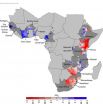(Press-News.org) Saudi Arabian researchers have detected genetic fragments of Middle East Respiratory Syndrome coronavirus (MERS-CoV) in the air of a barn holding a camel infected with the virus. The work, published this week in mBio®, the online open-access journal of the American Society for Microbiology, indicates that further studies are needed to see if the disease can be transmitted through the air.
MERS, a serious viral respiratory illness caused by the coronavirus, has been identified in 699 people as of June 11, according to the World Health Organization; 209 people have died from the condition. An additional 113 cases occurring between 2012 and 2014 were reported by the Saudi Arabian Ministry of Health on June 3.
For the study, researchers on three consecutive days last November collected three air samples from a camel barn owned by a 43-year-old male MERS patient who lived south of the town of Jeddah, who later died from the condition. Four of the man's nine camels had shown signs of nasal discharge the week before the patient became ill; he had applied a topical medicine in the nose of one of the ill camels seven days before experiencing symptoms.
Using a laboratory technique called reverse transcription polymerase chain reaction (RT-PCR) to detect gene expression, they found that the first air sample, collected on November 7, contained genetic fragments of MERS-CoV. This was the same day that one of the patient's camels tested positive for the disease. The other samples did not test positive for MERS-CoV, suggesting short or intermittent shedding of the virus into the air surrounding the camels, said lead study author Esam Azhar, PhD, head of the Special Infectious Agents Unit at King Fahd Medical Research Center and associate professor of medical virology at King Abdulaziz University in Jeddah.
Additional experiments confirmed the presence of MERS-CoV-specific genetic sequences in the first air sample and found that these fragments were exactly identical to fragments detected in the camel and its sick owner.
"The clear message here is that detection of airborne MERS-CoV molecules, which were 100% identical with the viral genomic sequence detected from a camel actively shedding the virus in the same barn on the same day, warrants further investigations and measures to prevent possible airborne transmission of this deadly virus," Azhar said.
"This study also underscores the importance of obtaining a detailed clinical history with particular emphasis on any animal exposure for any MERS-CoV case, especially because recent reports suggest higher risk of MERS-CoV infections among people working with camels," he added.
Meanwhile, he said, mounting evidence for camel-to-human transmission of MERS-CoV warrants taking precautionary measures: People who care for camels or who work for slaughterhouses should wear face masks, gloves and protective clothing, and wash their hands frequently. It is also important to avoid contact with animals that are sick or have tested positive for MERS-CoV. Those who visit camel barns, farms or markets should wash hands before and after contact with animals. In addition, pasteurization of camel milk and proper cooking of camel meat are strongly recommended.
INFORMATION:
The study was supported by King Abdulaziz University.
mBio® is an open access online journal published by the American Society for Microbiology to make microbiology research broadly accessible. The focus of the journal is on rapid publication of cutting-edge research spanning the entire spectrum of microbiology and related fields. It can be found online at http://mbio.asm.org.
The American Society for Microbiology is the largest single life science society, composed of over 39,000 scientists and health professionals. ASM's mission is to advance the microbiological sciences as a vehicle for understanding life processes and to apply and communicate this knowledge for the improvement of health and environmental and economic well-being worldwide.
Middle East Respiratory Syndrome coronavirus detected in the air of a Saudi Arabian camel barn
2014-07-22
ELSE PRESS RELEASES FROM THIS DATE:
Viral therapy could boost limb-saving cancer treatment
2014-07-22
Viruses designed to target and kill cancer cells could boost the effectiveness of chemotherapy to the arms and legs and help avoid amputation, a new study reports.
Scientists at The Institute of Cancer Research, London, tested the effectiveness of a genetically engineered version of the virus used to vaccinate against smallpox.
They found use of the virus alongside isolated limb perfusion chemotherapy – given directly to blood vessels supplying the affected arm or leg as an alternative to amputation – was more effective in rats than either treatment on its own.
The ...
New study finds high school lacrosse players at risk for concussions, other injuries
2014-07-22
Lacrosse is one of the fastest-growing high school sports in the United States, with more than 170,000 students now playing the sometimes hard-hitting game. The growing participation numbers, however, mean that more young people than ever are at risk of injury in lacrosse practice and competition.
In a study published online today by The American Journal of Sports Medicine and available in an upcoming print issue, researchers from the Center for Injury Research and Policy at Nationwide Children's Hospital and the Colorado School of Public Health found that high school ...
Schizophrenia's genetic 'skyline' rising
2014-07-22
The largest genomic dragnet of any psychiatric disorder to date has unmasked 108 chromosomal sites harboring inherited variations in the genetic code linked to schizophrenia, 83 of which had not been previously reported. By contrast, the "skyline" of such suspect variants associated with the disorder contained only 5 significant peaks in 2011. By combining data from all available schizophrenia genetic samples, researchers supported by the National Institutes of Health powered the search for clues to the molecular basis of the disorder to a new level.
"While the suspect ...
Largest gene discovery 'kick-starts' new search for schizophrenia treatments
2014-07-22
VIDEO:
Largest gene discovery helps 'kick-start' new search for schizophrenia treatments - The discovery of over a hundred genetic risk factors linked to schizophrenia provides vital new clues in understanding what...
Click here for more information.
The discovery of over a hundred genetic risk factors linked to schizophrenia provides vital new clues in understanding what causes the condition and will kick-start the search for new treatments, according to leading UK scientists. ...
International team sheds new light on biology underlying schizophrenia
2014-07-22
July 21, 2014 (Toronto) – As part of a multinational, collaborative effort, researchers from Canada's Centre for Addiction and Mental Health (CAMH) have helped identify over 100 locations in the human genome associated with the risk of developing schizophrenia, in what is the largest genomic study published on any psychiatric disorder to date. The findings, published online in Nature, point to biological mechanisms and pathways that may underlie schizophrenia, and could lead to new approaches to treating the disorder, which has seen little innovation in drug development ...
LSU's Mark Batzer contributes to Nature Genetics article on marmoset genome
2014-07-21
BATON ROUGE – LSU's Mark Batzer, Boyd Professor and Dr. Mary Lou Applewhite Distinguished Professor in Department of Biological Sciences in the College of Science, contributed to an article in the scientific journal Nature Genetics, titled "The Common Marmoset Genome Provides Insight into Primate Biology and Evolution," published on July 20.
Batzer contributed analysis of "jumping genes," or mobile elements that move by a sort of "copy and paste" mechanism in the genome. The marmoset is important because it is the first "New World" monkey genome to be sequenced.
An ...
Temple study compares deep vein thrombosis therapies
2014-07-21
(Philadelphia, PA) – Patients who have a clot in their legs and are considering whether to be treated with traditional blood-thinning medication or undergo a minimally-invasive catheter-based clot removal procedure should feel comfortable that there is no difference in death rates between the two treatments, although there are more bleeding risks with the catheter procedure, according to a study by Temple University School of Medicine researchers. The study involved a review of more than 90,000 cases nationwide.
Riyaz Bashir, MD, a specialist in interventional cardiology ...
'Moral victories' might spare you from losing again
2014-07-21
It's human nature to hate losing.
Unfortunately, it's also human nature to overreact to a loss, potentially abandoning a solid strategy and thus increasing your chances of losing the next time around.
That's one conclusion of a Brigham Young University study published this week by the journal Management Science. The finding is based on an analysis of two decades of data on NBA coaching decisions.
The researchers focused on whether coaches adjusted their personnel following games where the margin of victory or defeat was small. After narrow wins, coaches changed their ...
Water, water -- not everywhere: Mapping water trends for African maize
2014-07-21
Today's food production relies heavily on irrigation, but across sub-Saharan Africa only 4 percent of cultivated land is irrigated, compared with a global average of 18 percent. Small-scale farming is the main livelihood for many people in the region, who depend on rainfall to water their crops.
To understand how climate change may affect the availability of water for agriculture, researchers at Princeton University analyzed trends in the water cycle in maize-growing areas of 21 African countries between 1979 and 2010. The team examined both levels of rainfall and the ...
Global warming 'pause' since 1998 reflects natural fluctuation
2014-07-21
Statistical analysis of average global temperatures between 1998 and 2013 shows that the slowdown in global warming during this period is consistent with natural variations in temperature, according to research by McGill University physics professor Shaun Lovejoy.
In a paper published this month in Geophysical Research Letters, Lovejoy concludes that a natural cooling fluctuation during this period largely masked the warming effects of a continued increase in man-made emissions of carbon dioxide and other greenhouse gases.
The new study applies a statistical methodology ...


